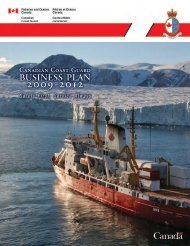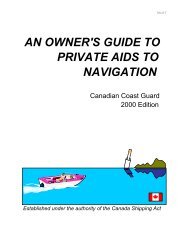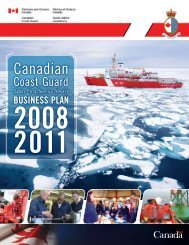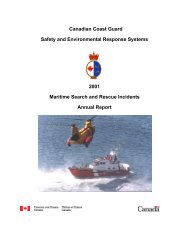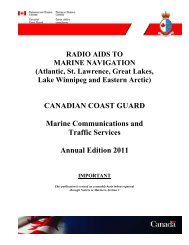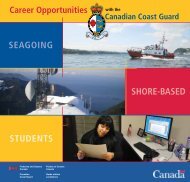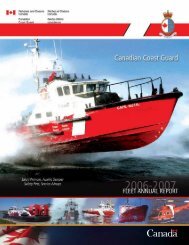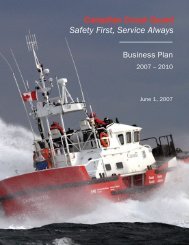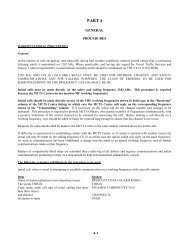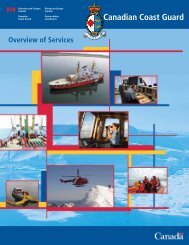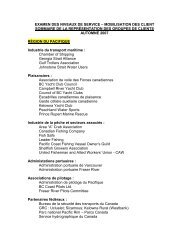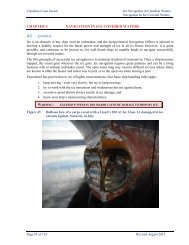RADIO AIDS TO MARINE NAVIGATION - Canadian Coast Guard
RADIO AIDS TO MARINE NAVIGATION - Canadian Coast Guard
RADIO AIDS TO MARINE NAVIGATION - Canadian Coast Guard
Create successful ePaper yourself
Turn your PDF publications into a flip-book with our unique Google optimized e-Paper software.
Table 2: Localized warnings<br />
Localized warnings/watches *<br />
Warning criteria<br />
Squall watch<br />
Squall warning<br />
Tornado watch<br />
Advance notice of conditions that are favourable to the development of squalls.<br />
Wind gust ≥ 34 knots associated with a line or an organized area of thunderstorms.<br />
Advance notice of conditions that are favourable to the development of Tornados.<br />
Tornado warning<br />
Evidence of tornado formation (radar, report from a reliable source, etc.) over a marine<br />
area, or an existing tornado moving from land to an adjacent marine area.<br />
Waterspout watch<br />
Advance notice of conditions that are favourable to the development of cold-air<br />
waterspouts.<br />
Waterspout warning<br />
Evidence of waterspout formation (radar, report from a reliable source, etc.) over a<br />
marine area.<br />
High water level warning<br />
To warn mariners and coastal populations of potentially hazardous impacts due to<br />
abnormally high water levels or waves along coastline areas.<br />
Special marine warning/watch<br />
Used to describe conditions other than those defined above that may have potentially<br />
hazardous impacts on navigation.<br />
Notes: * These warnings/watches are delivered using separate messages.<br />
Ice warnings: refer to the <strong>Canadian</strong> Ice Service further down in this chapter.<br />
Marine and Ice Forecast program<br />
Marine forecasts are issued for the offshore economic zone including the St. Lawrence Seaway and major inland waters.<br />
For sea ice, ice forecasts are issued for offshore marine areas as well as the Great Lakes. The production schedule is<br />
detailed in each regional section of this chapter. The forecast program includes the following bulletins:<br />
Table 3: Marine forecast program<br />
Forecast or bulletin name<br />
Details<br />
Technical marine synopsis<br />
Provides the positions and trends of the main weather systems for the forecast<br />
period covering Days 1 and 2.<br />
Provides information on: synoptic warnings, wind, visibility, precipitation, and<br />
Marine forecast (or Regular marine<br />
freezing spray. It may include air temperature as appropriate. Valid for Days 1<br />
forecast)<br />
and 2.<br />
Recreational boating marine forecast<br />
Tailored to the needs of recreational boaters, it is available on a seasonal<br />
basis and only in specific regions.<br />
Marine weather statement<br />
Issued when deemed necessary, it provides additional information on<br />
potentially high impact marine conditions.<br />
Wave height forecast<br />
Provides information on significant wave heights valid for Days 1 and 2. It is<br />
not available for the Arctic waters or Hudson Bay.<br />
Extended marine forecast<br />
Primarily used as a planning tool, it provides an extended marine wind outlook<br />
for Days 3, 4, and 5.<br />
Iceberg bulletin<br />
Provides information on distribution of icebergs valid for the time of issue of<br />
the bulletin.<br />
Ice forecasts Provides information on hazardous ice conditions valid for Days 1 and 2.<br />
International Maritime Organization (IMO)-compliant NAVigational TelEX<br />
NAVTEX (1)<br />
bulletin issued with each regular marine forecast or ice forecasts in a<br />
standardized abbreviated format - see Table 5 for Abbreviations.<br />
MAFOR (1)<br />
This is a specialized coded marine forecast produced for Quebec and Ontario.<br />
More details on NAVTEX and MAFOR are provided after this section.<br />
(1)<br />
5 - 2



